Spirit News
Confident Horse Confident Rider May 17,18,19 2024
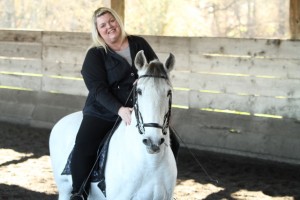
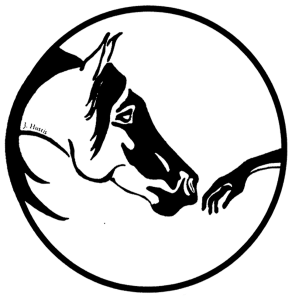
Reach out to Horses approved curriculum for this clinic – as taught by Spirit Horse Center owner, trainer and instructor Staci Grattan
CONFIDENT HORSE, CONFIDENT RIDER
May 17,18,19, 2024 Confident Horse Confident Rider 3 day clinic with Holistic Horsemanship Instructor Staci. We will be accepting a limited number of participants and auditors for this clinic. Bring your own horse in for a great clinic designed to set you up for success as you enter the 2024 summer riding season. Activities will include, our ROTH patented TLC (trust based leadership and compassionate communication) methodology, spook busting, obstacle course work and more. It’s set to be a brilliant three day clinic filled with connection and education! We cannot wait!
*EARLY BIRD PRICING $475 if paid in full by the early bird date of 4-1-24
*$525 if paid in full after 4-1 and on the registration deadline of 5-1-24 with a deposit made by 4-1. *235 deposit due by 4-1-24 to hold your spot (non refundable)
*This clinic will have limited participant slots available – we anticipate this will fill quickly. If we do not have your down payment by April 1st we will be forced to let your slot go to someone else.
*We will have snacks, water and coffee available. Plan to pack a lunch and any additional beverages you may desire.
*Helmets, long lines and dually halters are strongly suggested. We will have some here for sale of you do not own one.
*Auditing available $30 per day or $75 for all three days if paid by 5-1-24 (non refundable for any reason) $100 at the door.
*All fees and deposits pertain only to this clinic and are non refundable and non transferable (for any reason)
Link to register and pay:
https://form.jotform.com/233025420209039
Plant Medicine Workshop with Michelle Patterson June 8th, 2024
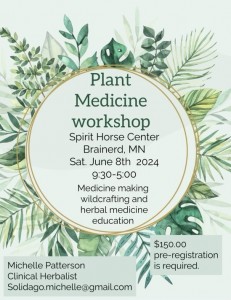
Clinical Herbalist and Bowen Instructor Michelle Patterson will be at Spirit Horse Center teaching a Plant Medicine workshop Saturday June 8th, 2024. The day will be packed with information and a trip around our property to collect plants and make remedies.
email Michelle to register or for more information at solidago.michelle@gmail.com
2024 Clinics at Spirit Horse Center
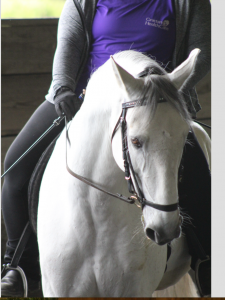

Reach out to Horses approved curriculum for the following clinics – as taught by Spirit Horse Center owner, trainer and instructor Staci Grattan
CONFIDENT HORSE, CONFIDENT RIDER
May 17,18,19, 2024 Confident Horse Confident Rider 3 day clinic with Holistic Horsemanship Instructor Staci. We will be accepting a limited number of participants and auditors for this clinic. Bring your own horse in for a great clinic designed to set you up for success as you enter the 2024 summer riding season. Activities will include, our ROTH patented TLC (trust based leadership and compassionate communication) methodology, spook busting, obstacle course work and more. It’s set to be a brilliant three day clinic filled with connection and education! We cannot wait!
*EARLY BIRD PRICING $475 if paid in full by the early bird date of 4-1-24
*$525 if paid in full after 4-1 and on the registration deadline of 5-1-24 with a deposit made by 4-1. *235 deposit due by 4-1-24 to hold your spot (non refundable)
*This clinic will have limited participant slots available – we anticipate this will fill quickly. If we do not have your down payment by April 1st we will be forced to let your slot go to someone else.
*We will have snacks, water and coffee available. Plan to pack a lunch and any additional beverages you may desire.
*Helmets, long lines and dually halters are strongly suggested. We will have some here for sale of you do not own one.
*Auditing available $30 per day or $75 for all three days if paid by 5-1-24 (non refundable for any reason) $100 at the door.
*All fees and deposits pertain only to this clinic and are non refundable and non transferable (for any reason)
Link to register and pay:
https://form.jotform.com/233025420209039
____________________________________________________________________________________
Mini Clinic – Horse Spa Day July 20th, 2024 10am-2pm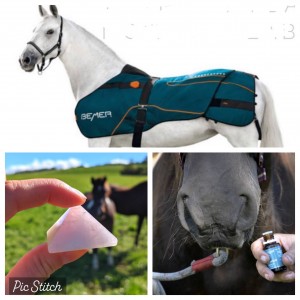
You asked and we delivered! The first in our series of mini clinics in which you bring your horse to Spirit Horse Center for a half day or learning and fun!
In this horse spa day we will be exploring The Bemer Blanket and Leg Cuffs, Essential Oils and Crystals/Gemstones. Dip your toe in the water of non traditional spoiling and pampering for your horse and take home some new fun techniques and or items to support your equine’s physical and emotional well being.
During the clinic you will work with your horse to apply a Bemer treatment, discover which essential oils he or she prefers and which crystals or gemstones support emotionally and physically. Time permitting we will also touch upon Crystal grids to manifest and or support your physical, emotional or performance goals.
Join us for a fun day in our indoor arena out of the bugs and bond with your partner on a whole new level!
Cost $100
Must pre- register. Non refundable. First come first serve. Must register and pay by July 1, 2024
Spots are limited.
Contact us at 218-825-4944 (text or call) to register or for more information.
Registration Jotform coming soon
____________________________________________________________________________________
HOLISTIC HORSE DAY October 11th, 2024
October 11th, 2024 Holistic Horsemanship Day with Holistic Horsemanship Instructor Staci explore muscle testing, animal communication, and the nature of the horse in this awesome day jam packed with information.Follow us on social media and keep checking back for registration details. This will be largely an informational and demonstration clinic – there will be some hands on opportunities and exercises however there will not be a ton of hands on horsemanship this day. You may combine with the two day liberty clinic October 12&13 for hands on horsemanship (register for all three below). This is a day set for multiple participants to enjoy and we explore several aspects of holistic horsemanship. This is a great day outing for friends to attend together and enjoy. Physical demand level is very low for this day.
* EARLY BIRD PRICING $99 if paid in full by September 15th, 2024 (non refundable non transferable)
*$125 if paid after September 15th, 2024
Registration form:
https://form.jotform.com/241004898920155
___________________________________________________________________________________
LOVING LIBERTY CLINIC October 11,12,13, 2024
3 day clinic
Day one you will join us for the Holistic Horse Day on October 11th (see info above)
Clinic Participants will then join us with their horses (or you can work with one of our fabulous school horses) October 12 and 13 to experience the joys of liberty work with Holistic Horsemanship Instructor Staci.
Experience the Obstacle Course at Liberty and Free Schooling in the Round Pen.
Follow us on social media and keep checking back for registration details.
We will be accepting a limited number of participants and auditors for this clinic.
*EARLY BIRD PRICING $475 if paid in full by the early bird date of 9-1-24
*$525 if paid in full after 9-1 and on the registration deadline of 10-1-24 with a deposit made by 9-1. *235 deposit due by 9-1-24 to hold your spot (non refundable)
*This clinic will have limited participant slots available – we anticipate this will fill quickly. If we do not have your down payment by September 1st, we will be forced to let your slot go to someone else.
*We will have snacks, water and coffee available. Plan to pack a lunch and any additional beverages you may desire.
*Helmets, long lines and dually halters are required. We will have some here for sale of you do not own one.
*Auditing available $30 per day for the 12th and 13th. ALL persons attending the Holistic Horse day on October 11th as a single item (not attending the clinic as a participant) must register and pay the $100 fee as listed above.
*All fees and deposits pertain only to this clinic and are non refundable and non transferable (for any reason)
JOTFORM TO REGISTER FOR THIS CLINIC AS A PARTICIPANT OR AS AN AUDITOR
https://form.jotform.com/241004898920155
Email, call or text for more information 218-825-4944 or info@spirithorsecenterinc.com
COMING SOON:
Intro to Enlightened Riding and Intuitive Connection Mini Clinic with Staci
Intro to Kinesiology testing for Nutritional Supplements
Stay tuned to social media and keep checking back here for details.
Equine Bowen Work Level One with Michelle Patterson April 25-28, 2024 at Spirit Horse Center
Equine Bowen Therapy taught by Michelle Patterson
* A Soft Tissue Therapy
* Release Tension Patterns
*Release Stored Trauma
* Promote Healing and Well Being
American Bowen Academy
To register Contact Michelle Patterson 1320-293-2470 email solidago@gmail.com
BEMER Horse and Human PEMF Products
Spirit Horse Center – Owner Staci is now a proud BEMER Horse and Human PEMF Device dealer!
Click below for our Bemer Store link
spirithorsecenterinc.bemergroup.com
DID you know that electricity is running through your body right now? All living things generate electricity and without it we cannot live! The elements in our cells (think oxygen, hydrogen and carbon) carry different electrical charges to create electricity and send vital signals to different parts of the body. (Source: University of Maryland)
All of these vital materials are transported throughout our body via the circulatory system. So both electricity and blood flow are crucial to maintain and sustain optimal physiological function.
This incredible stacked signal patented PEMF Bemer technology provides incredible recovery and healing energy for horses and humans. PEMF stands for Pulsed Electromagnetic Field. Devices that use PEMF technology for therapy produce electromagnetic fields with various waveforms and frequencies that stimulate healthy muscles in order to improve and facilitate muscle performance. Uniquely, the BEMER device thereby temporarily increases local blood circulation in healthy leg muscles.
The effectiveness of these waves depend on specific parameters to target our cell tissues. Much like a musical song that has a specific melody, rhythm and tempo, PEMF therapy devices deliver waves in an organized sequence (melody), at specific frequencies (rhythm) set to a certain pulse (tempo).
How can Bemer help you or your horse?
Local and targeted PEMF therapy directly stimulates electrical activity within the muscle tissues “the field” interacts with. Think of charging a toothbrush or a cell phone wirelessly. The concept works the same within the body. But instead of charging a battery – you are charging your cells! When your cells are charged, they can provide the highest level of functionality to you, supporting your optimal performance and expedited recovery. BEMER works in concert with your body, enhancing the vitality within.
Why Bemer and not other PEMF devices?
BEMER stands for Bio-Electro-Magnetic-Energy-Regulation. BEMER devices use a pulsed electromagnetic field (PEMF) to deliver a patented bio-rhythmically defined therapeutic signal.
BEMER is a unique FDA Class II cleared PEMF device designed specifically to target the circulation within the musculature in healthy leg muscles — the core system necessary for optimal health. Dr. Rainier Christian Klopp dedicated more than 20 years of his life and career to studying the relationship of electromagnetic therapy and the effects on blood flow and the microcirculatory system.
NASA is incorporating BEMER patented technology into the space shuttles to support the astronauts keeping them healthy in the rigors of space and Harvard recently did a study on the effectiveness of BEMER technology.
Blood is the body’s universal means of transport; oxygen, nutrients, chemical messengers (e.g., hormones) and immune cells are all transported through our blood. When our body’s cells, tissues and organs are adequately nourished and metabolic waste products are removed, our bodies are more healthy and function properly.
Many physical discomforts and impairments are directly related to diminished circulation. This is because healthy circulation is the cornerstone of health! Without good blood flow, you simply cannot be at your best.
BEMER’s patented signal has been scientifically shown to temporarily improve blood flow in healthy leg muscles.* Improving local blood flow circulation within the muscle tissue is vital in optimal muscle function and perfomance.*
*These statements have not been evaluated by the FDA. BEMER does not provide any medical advice or services. This device is not intended to diagnose, treat, cure or prevent any disease. It should not be used for any purpose other than as described in the user manual. Please consult your own healthcare provider if you have any medical issues.
BETTER CIRCULATION MEANS:
BETTER SUPPLY OF NUTRIENTS
BETTER DISPOSAL OF METABOLIC WASTE
WHAT SETS BEMER APART
- Unique & Patented
- Specific Delivery Configuration: A specific frequency over a specific timeline
- Results: Studies in PubMed.gov
The unsurpassed BEMER signal sets a new standard in the industry with its complex, carefully tuned configuration and timing. Nearly two decades of research and development have resulted in BEMER’s unique bio-rhythmically defined signal. This signal is patent-protected, a feat of German engineering, and used exclusively by BEMER. Complex calculations and processes are the basis of the signal’s creation by the B.Box control unit. The signal is then transmitted to the application module for delivery into the body.
Chemical Free Fly Spray Recipe – Essential Oils
Made with Young Living Essential Oils – Staci has been a Young Living Distributor for well over a decade and grew up learning how to work with them from her Grandmother DeLyte who was one of the original YL Distributors in the early 90s!
Call Staci at the barn to order your oils 218-825-4944 or email info@spirithorsecenterinc.com. You can also find our barn on Facebook and send a message there. Spirit Horse Center Inc. in Minnesota.
Ive been formulating this recipe for years. Please enjoy.
Spirit Horse Center Fly Spray Recipe
In a 16oz spray bottle:
**Leave a little room at the top for soap and oils 3 parts water
1 part mineral oil
1 tablespoon Dawn dish soap
10 drops Peppermint oil (flies)
10 drops Purification oil (gnats and mosquitos) 10 drops Aroma Siez (Young Living blend)
Change up your spray throughout the season as the flies get dull to it. You can also change it to respond to what types of insects your herd is combatting.
Lots of mosquitos and gnats? Add one or more of the following: Purification oil (5-10 drops) Melrose oil (3-5 drops) Melaleuca oil (5 drops)
Flies really bad?
Add one or more of the following: Peppermint (5-10 drops)
Aroma Siez (5 drops)
Clove oil (3 drops)
Idaho Tansy (3 drops)
Lavender (5-10 drops)
Horse flies leaving welts?
Add 1⁄2 tablespoon more Dawn dish soap
Spray chests, bellies, legs (inside and out) and both sides of the neck liberally for the best results.
Spirit Horse Center Testimonial:
“We have found that most of the time we do not NEED to use commercial fly spray. Commercial spray can cost upwards of $30 per bottle. Our horses are much happier with this nontoxic/cost efficient blend, as are we!”
Spirit Horse Center also suggests Young Living Animal Scents ointment to areas affected by insect bites.
101 Things to do with your Horse!
Do you love your horse? Silly question I know.
But, do you find yourself wishing you could do more with them than just ride? You groom and ride and groom and feed and… then you spend time with them… “just being”. Which is great! But then what? What else is there is to do?
“I watched the first clip of the 101 series.It is just awesome! I feel like I am right in the middle of it. Anna and the beautiful Charlotte in my living room. This is very beneficial to keep me on my toes. I could watch this countless times and still learn more about the conversation.” Carolina in New Mexico
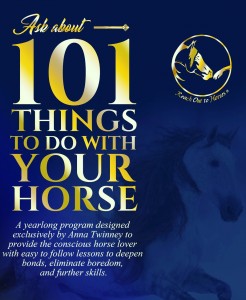
Welcome to 101 Things to do with your horse!
Created by our mentor Anna Twinney of Reach Out to Horses – there are already hours of videos and more being added weekly. Discover new ways to spend time with your horse and unlock new levels of partnership. We are using this program here at our facility and loving it!
As a Reach Out to Horses affiliate and because Staci is a Reach Out to Horses Certified Trainer – we are able to offer this awesome video opportunity and get credit here at our facility!
This program is a game-changer. It is going to not only change what you do with your horses but also your partnership, your bond, and your knowledge. In short it is going to change everything about your horsemanship and your relationship with your equine companion.
What is 101 Things to Do with Your Horse?
101TDwYH is an online, streaming program that will give you tons of ideas, activities, and tips to try with your horse. You will never be bored again or lost for something to do.
For an entire year, you will unlock 2 short video lessons each week. The video lessons run an averages of between 7-10 minutes and they will teach you everything you need to know to try the exercises for yourself, on your time. And what’s even more exciting is that the topics of the activities vary so you won’t be doing the same thing, or variations on the same theme, over and over again.
Topics of the lessons include:
- Authentic equine communication, connection, and collaboration
- Discovering new possibilities of liberty and profound life lessons for you and your horse
- Energy healing, health, nutrition and multiple alternative healing modalities for your horse
- Positive reinforcement techniques personalized and expanded for training tricks
- Mindful meditation that will open up the silent and secret telepathic language of your horse
- Eliminating gadgets and experiencing the freedom of bitless and bridle-less riding
- Experiencing the benefits of collaborative leadership vs dominance-based one-way dialogue!
- And lots and lots more!
For more info about Staci and our staff click here
To purchase 101 Things, for more info or to watch an informational video on 101 Things – click here
To read Anna Twinney’s bio click here
Chemical Free adjunct to traditional worming – Why and How
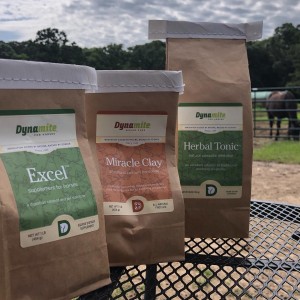
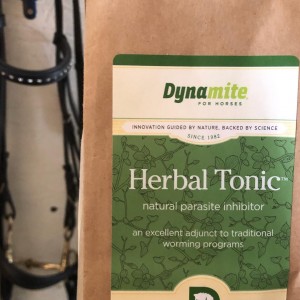
Chemical Free – Dynamite Protocol – Spirit Horse Center Inc.
Spirit Horse Center Brainerd, Minnesota – Telephone 218-825-4944
Email – info@spirithorsecenterinc.com
Interested in chemical free worming inhibitor? We’ve got the solution and proven results for you! In the summer of 2019 we ran the Dynamite chemical free protocol on a few of the horses here on the property. We took fecal samples before and after and are very pleased with the results. Below is our online link to order yours and have it shipped directly to your door (or you can message and or stop by the barn and pick yours up – please do use our link if you order online so we get credit). All natural, chemical free – stop feeding your horses toxic ingredients that can negatively impact their health!
DYNAMITE online ordering link for Spirit Horse Center:
SPIRIT HORSE CENTER DYNAMITE WEB LINK
PROTOCOL:
PLEASE NOTE – seven day protocol must be done over a full moon phase (explained in article) so you will need to plan ahead accordingly. 28 day protocol can be done any time.
Parasite control is all about the immune system. Consider this possibility: Animals have parasite overloads because they are unhealthy. The worms are not the first cause of the health problem! A healthy immune system fights off parasites and is actually stimulated by the presence of a small number of parasites. Healthy animals have less parasite challenges because their balanced systems do not support large parasitic colonies. Keeping your animal’s immune system healthy and managing the parasite load is key.
To avoid or limit the use of chemical dewormers, Dynamite recommends the use of Herbal Tonic™ as an excellent way to assist in parasite control. It is NOT a dewormer but is filled with traditional vermifuge herbs used for centuries to control internal parasite infestation and is a great addition to the Dynamite Foundation program, which in and of itself, does a great job of limiting parasite overload. Balanced nutrition leads to better parasite control.
One of the best and easiest ways to give your horses Herbal Tonic is by using Dynamite’s Parasite Cocktail.
Purchase the entire seven day worming package here or buy individually: Judys Parasite Package
DYNAMITE’S PARASITE COCKTAIL FOR HORSES
2 cups of hay pellets
2 heaping tablespoons of dry Miracle Clay
2 scoops of Herbal Tonic
1 scoop Excel
3 small squirts (1 teaspoon) of Dyna Pro
Add hot water and stir to consistency of thick mud
TIMING OF HERBAL TONIC USE
When feeding Herbal Tonic, no other vitamin or mineral supplements are needed.
Option 1: 7-Day Protocol
The moon affects the tides of our bodies, hydration levels, and fluid levels. Worms become more active and shed eggs during the full moon so it’s the perfect time to feed Herbal Tonic. Three days before a full moon, when parasites are most active, administer 2 ounces of Herbal Tonic twice daily (or the Parasite Cocktail once a day) for 7 days. If you miss the full moon window of time, just do the best you can for seven days or consider the 28-day protocol.
Option 2: 28-Day Protocol
For a full month, administer 1 ounce of Herbal Tonic daily for 28 days. This can be done at any time during the month.
The first time you feed the “cocktail” they may not like it. After about a day, however your horse will dive into it. They will feel your energy that this is good for them and it will help them. Adding a shredded carrot is always helpful.
We also would recommend no horse shows, stress, work, etc. Let them heal and take it easy this week.
At the end of the 7-day (or 28-day) protocol, return to the Dynamite Foundation products and add one teaspoon of Excel daily for digestion support.
Protocol frequency depends on your particular geographic location. It is not necessary to worm in the winter when eggs and worms are frozen.
It might take up to 2 years of chemical-free feed, optimum minerals, detox work, and holistic methods to get the conventionally-fed, oft-dewormed, and vaccinated horses “up to speed” where their bodies can effectively deal with parasite challenges on their own.
ADDITIONAL INFORMATION
What about this protocol for my dog or goat or…? Does herbal tonic only work for horses?
Herbal Tonic is a Dynamite product that can be used on many species: dogs, cats, goats…almost any mammalian species. We sell an Herbal Tonic product labeled for horses and one for dogs but the product ingredients are the same so it can be used on any species. For large animals use the dosage indicated on the equine packaging.
The parasite “cocktail” for dogs, cats, and other small animals will only consist of top-dressing their food with Miracle Clay (approximately 1 teaspoon dry), Dyna Pro and Herbal Tonic. Please see packaging for proper dosage for dogs, cat, and smaller animals.
When deworming a heavily parasitized animal, always start slowly and work your way up. A massive parasite die-off can release too many toxins into the animals system at once. How do you know if they are heavily parasitized? It all goes back to a fecal egg count. This is always step one.
WHY GO CHEMICAL FREE?
Shari Frederick of the Holistic Horse, in her article, Wormers, Toxic Reaction and Natural Alternatives, said, “Today’s horses are experiencing extremely adverse side effects to chemical wormers at an alarming rate!” Ranging from mild to severe, stress reactions within one hour of chemical worming may include: Loss of control-resulting in the horse dropping to the ground, tongue hanging from mouth accompanied by drooling, swollen neck, puffy lips and tongue, noticeably red gum burns, colic, allergic reactions, laminitis, various gut disturbances, and skin reactions, including bald patches. Most visible problems appear to subside within an hour.
Chemical deworming, especially over-worming, can damage the immune system of your horse. Life threatening internal damage can result from worm infestation, yet regularly compromising your horses immune system can be more harmful than the worms. Drugs and chemicals are breeding stronger enemies and can lead to toxicity. Often parasite-infested horses are the ones who are dewormed most frequently! They are less likely to fend off parasites as time goes on because they can’t build their own defenses. Interestingly, the practice of regular deworming didn’t begin until the 1960s. In the 1980s worming was only an occasional support. Chemical wormers alter your horses intestinal environment. Use a probiotic one week before and after worming to maintain healthy bacteria, and administer wormers with feed to minimize gut issues. Chemical wormers contain neurotoxins that target various worms. For more optimum results target both the adult worm and larvae. Any class of anthelmintic (medication causing the evacuation of specific worms), once resistant to a de-wormer, will indefinitely be ineffective.
Toxicity levels of wormers are continually being raised to cope with resistant worms: Raising toxicity levels in wormers hastens the development of worm resistance and exposes horses to unnecessary toxic chemicals. Synthetic wormers actually poison worms and protozoa, and at the same time overstress the liver and kidneys, forced to filter the poisons. Long-term exposure to these toxins can actually shut down organs! The greater the toxicity levels of chemical wormers, the greater the risk of overdosing.
Fecal test every three months. Worms may go undetected because they are rarely seen in the manure. If you have the lab count the number and types of parasite eggs, the degree of infestation can be determined. A false negative (a zero egg count) can result if the parasites are not actively releasing eggs or are in the small intestine, liver, heart or lungs (migrating through the body). The worms may be too sick to lay eggs, butnot die. Smaller species eggs might even be broken down by digestion. Some may simply continue to migrate through tissues until they finally die. The encysted stages of a small red worm will not show up on a fecal test. Regular re-testing will more accurately determine worm presence, as will clinical signs. Better safe than sorry? Not every horse in the barn needs worming at the same time. Each horse needs to be tested. Variance in worm testing within a herd is the perfect example of how routine chemical worming can be an unnecessary toxic burden on horses.
HEALTH CONDITIONS AND LIVER TOXCITY ARTICLE BY DYNAMITE GOLD DIRECTOR JUDY SINNER
This article has morphed fairly dramatically in the last 4 years, since it first was published. As more info has become available on the parasite resistance to all wormer classes, and even mainstream vets are now advocating alternatives of building the immune system and worming only upon high fecal counts, these natural methods are more important to the health of our equine friends than ever before.
I personally have 10 horses, ranging in age from 4 to 26. The four year old has never had a chemical dewormer, and he is spectacular, he is Generation 4 bred and raised on DYNAMITE®. His 13 year old dam has had perhaps 3 doses of paste dewormer in her whole life. The others are all late teens and up, and endured my well-meaning frequent doses of wormers in their early years, and thankfully have done far better the last 15 years on just an occasional spring dose of Safeguard or maybe Strongid P. They get Herbal Tonic™ for 28 days spring and fall, and daily Excel™ at 1 tsp a day the rest of the time. I have also noted that Miracle Clay™ seems to repel worms…it has a strong paramagnetic charge, while parasites are diamagnetic in nature. S.O.D. will even sometimes be the natural parasite control of choice. Dapples and toplines are spectacular, weight is awesome on TNT™ and no grain for most, a cup or two of our Pelleted Grain Ration™ for the upper 20’s geldings, grass hay free choice. Note that I consider them spectacularly healthy, and that it might take up to 2 years of chemical free feed, optimum minerals, detox work and holistic methods to get the conventionally-fed, oft-dewormed and vaccinated horses “up to speed” where their bodies can effectively deal with parasite challenges.
The parasite issue for our horses, dogs and other animals is one of the most charged subjects in animal management. Positions range from “I must administer a dewormer either daily, monthly or semi-monthly or my animals are at great risk” to the opposite paradigm, “I am not going to give my animals a toxic chemical, I will just use herbs or other natural substances”. I would like to address the subject of BALANCE and offer information that will assist animal caretakers to make informed decisions. Remember that many animals are alive and healthy today because chemical wormers came on the scene, while many horses and dogs do better on herbal products, and that “wholistic” treatment can mean all-encompassing, using both allopathic methods and complementary methods when appropriate.
Consider that a chemical dewormer is by nature and design a toxic substance, designed to kill or disable parasites, and hopefully not cause too much damage to the host animal in the process. The trick is to find the dose and frequency that works in each situation, and that may or may not be a “one size fits all” prescription. Worming more often than necessary can contribute to liver toxicity which stresses the animal unnecessarily, actually weakening the body and making it more of a target for parasite infestation. Remember, after all, parasites, insects and disease are “Nature’s Garbage Collectors”, designed by the Grand Scheme of Things to stress and eliminate the weak and unhealthy animal or plant, recycle it back to the earth and start over, thus sparing resources for the healthy and viable. Consider the possibility that animals have parasite overloads because they are unhealthy, not that the worms are the first cause of the health problem!
Donna Starita Mehan, DVM says, “Chemical wormers are accumulated and processed in the liver. When the liver becomes overwhelmed, it moves out of first stage storage and detox and into second stage, the byproducts of which are metabolites which are toxic to the cells. Now the animal is coping with the parasite, the toxic effects of the wormer, the health issues which precipitated the original health crisis which allowed the parasite to overgrow in the first place, plus the second stage liver metabolites.The overall result is a progressively downward spiral into increased toxicity, increased numbers of parasites, and increasingly more serious health problems. (EPM?).”
Anecdotally, we have seen many horses over the years crash with “EPM-like” ataxia and CNS problems following deworming. Some of the popular deworming drugs are neurotransmitter inhibitors, and seem to affect some horses’ coordination with repeated use. When an animal has a toxic liver for any reason, the production of cholinesterase, an enzyme necessary for transmission of nerve signals to the muscles, is impaired. In dogs, this same liver toxicity problem manifested in an experience that Sr. Director Ray Brinlee had with clients who run racing Greyhounds. The animals were winning consistently on Showdown®, and then each month when they got their heartworm medication (required by the track) they would pathetically lose their races that week, before regaining performance. So Ray had them give the dogs our human S.O.D. supplement to support the liver and the immune system just before and for 3 days after the worming, and the performance dip stopped – they just won right on thru the month!
In my own horses, I have noted one family in particular, descended from a wonderful old Arab/Saddlebred mare, who would “just go to Hell in a handcart” when they got a dose of a popular deworming product. Weight loss, hair coats dulling and growing long even in the summer, colic episodes, just general decline. So many years ago (15!) I quit using that particular dewormer on her descendants and all my horses, and they do just fine. Pay attention to your animals, they will tell you.
This quote from The Rest of the Story About Agriculture Today expresses an eloquent viewpoint: “Just as good health and vigor protects plants from their pests and diseases, so also are animals (and humans) protected from parasites and diseases. Are infectious diseases caused by germs? Well, yes, but… we are surrounded by disease germs daily, but as long as we are in good health – get plenty of sleep and eat a good diet – we don’t get sick. Usually, it is only when an animal is under stress– in poor health–that disease pathogens can get a foothold. Healthy animals have various defenses against parasites and diseases, including antibodies and white blood cells. It is well known among animal breeders and geneticists that the offspring of certain crossings are resistant to insects and diseases. (J. Blakely & D.H. Blade, The Science of Animal Husbandry, 1976, p. 129.)
“Organic farmers often report that their livestock are not bothered by flies. Veterinarian Dr. John Whittaker, writing in Acres U. S. A., (Dec. 1975, March & April 1975), states that B Vitamins, Vitamin C, and other nutritional factors play an important role in protecting animals from parasites and diseases; for example, an imbalance of dietary calcium and phosphorus or a magnesium deficiency increases parasitic worm infestations, while a high carbohydrate diet increases the infection of Balantidium, a protozoan intestinal parasite.
He notes that too much soluble nitrogen (non-protein nitrogen) or urea in feed causes high blood urea or ammonia levels, leading to reduced resistance to bacterial infections. Resistance to parasites and diseases can also be lowered by vaccinations and antibiotics (these can kill rumen microbes, leading to toxic mold infections), worming medicines, moldy feeds (through mold-produced toxins, including aflatoxin), and stresses (weather, noise, moving, and diet changes).
“The basic approach of the experts to weeds, insects and diseases is to identify the pest involved and zap it with the recommended poison. But actually, pest attack is a symptom of plant and animal deficiencies and malnutrition, not the cause of the illness,” Donna Starita, DVM, echoes a similar sentiment. She states that she sees more cases of colic and verminous arteritis in her practice in horses that are wormed daily or semi-monthly than in horses that are not wormed as frequently. Research veterinarian L. Phillips Brown speaks of the coming of “functional medicine”, where treatments and dosages are based on individual needs. Wholesale worming by the calendar may not be the answer for many animals.
Parasite resistance to all the modern wormer classes is now being reported. Director Penny Jones in WA, says, “Thought you would be most interested in this article in the Veterinary Record, the most prestigious research magazine for vets. OK….are they now saying what you and Regan and DYNAMITE® have been saying for years??!! Now maybe we can’t be shot if WE suggest horses should be wormed only if infested to the degree the horse is harmed or infecting other. I believe there will be more on this. If nothing else, we can quote Dr. Ray Kaplan and friends.”
To summarize the article, on 44 horse properties with 24 or more horses, all had benzimidazole resistance, and 48 percent had pyrantel resistance. The latter is presumed to be due to the use of daily wormer. “Development of an effective immune response is important to ameliorating disease.” states the article. They agreed that fecal egg counts were the most useful guide to the need for treatment. The figure of 200 eggs per gram was given as the threshold to begin treatment with deworming drugs. This treatment should be based on the egg counts of individual horses, not on regular periodic dosing. It was suggested that horses with fewer than 50 eggs per gram be ignored as sources of potential contamination. The study concluded that regular use of moxidectin (Quest) increased the risk of resistance to this class of drugs, and that it’s use should be limited. The conclusion: “It is vital for horse health to maintain the efficacy of anthelmintics, particularly the macrocyclic lactones (ivermectin, abamectin and moxidectin). To do this will require a major change in thinking about the way anthelmintics are used – from preplanned treatments to treating only those horses that require treatment and reserving larvicidal drugs for those animals where large numbers of larvae are likely to be present in the mucosa.”
The clinker here is that resistance to the ivermectin-type wormers is also being reported. Horse Journal in November 2003 states, “The Journal of the American Veterinary Medical Assn reports the failure of ivermectin to eliminate roundworm infestation in 20 out of 37 foals treated with ivermectin. In some foals, the counts kept increasing between the time of treatment and a recheck 12 to 13 days later…the ivermectin failures occurred mostly in foals that had been born on the farm and were regularly dewormed with ivermectin since birth, both suggesting the emergence of an ivermectin-resistant roundworm on this farm… intensive use of ivermectin puts considerable pressure on the parasites to evolve to a resistant form.” (And I might add, continual deworming that does not clear the parasite load most likely just stresses the horse unnecessarily, making them even more of a target for the parasites to overgrow.)
One suggestion the article makes is to deworm only high risk horses or those with high egg counts, and skip the other horses so that there are parasites present to interbreed with the resistant strains, thus lowering the possibility of totally resistant parasites. So…the concensus still appears to be to stop using dewormers at regular intervals, to rotate classes or wormers, and to deworm only on an as-needed basis. So how do we know “how much is too much” or when to deworm or how to control the parasite load at an acceptable level? Fecal samples, muscle testing, parasite point reflex testing, general observation and consideration of exposure to reinfestation all can be reliable indicators.
The observation of many old time cattlemen and horsemen who recognized parasite infested animals by the “fading” of the coat color intensity, which is another sign of copper deficiency (in people as well!). Bays and chestnuts will be “washy” and lighter-colored than normal, and the blacks will have a definite reddish cast. Angus cattle will look redder, and Herefords will be yellowish. Usually the hair will “fishhook” as well, sort of curling up at the ends and looking fluffy rather than laying flat. Dogs will show similar coat fading, especially noticeable in breeds like Dobies and Rotts. To follow this a little further, dog handlers who insist on ignoring our caution to not feed Dyna-Coat™ all the time have complained of a reddish cast to the coat after months on the product, which is high in zinc and would of course suppress copper over a period of time. Some dog handlers have discovered that feeding the human S.O.D. product to dogs for 10 days or so before a show will darken up coat and mouth pigment, since S.O.D. is high in copper. (Since I am already digressing furiously, I might as well keep on going.) An Acres USA article stated that animals with darker coat pigment require more copper than animals with lighter hair coat color! A great incentive to make sure that your horses have free choice access to 2 to 1 and 1 to 1, both of which contain chelated copper with the other nutrients. Users have noticed the horses increasing consumption of these products at times of stress, weather changes, parasite challenges, etc. They know what they need! Darker coated horses and greys may need a quarterly 10 day regimen of our S.O.D. for Horses to boost the copper levels.
Copper is also a major nutrient support for blood vessel strength and integrity, along with Vitamin C. So does it follow that animals deficient in these nutrients might be more at risk for parasite-induced aneurysm? Which comes first, the deficient animal or the parasite damage to the tissues? My fervent hope is that parasitologists will become more interested in studying the effect that the immune system and diet plays in parasite infestation or resistance. “Why does the animal become infested?” might be a more appropriate question than “How do we kill the worms?”
So, what to do? There is a plethora of products on the market for which anti-parasite properties are claimed: diatomaceous earth, garlic, black walnut hulls, MSM, clays, etc. In my experience and observation, these herbal assists have their place in parasite control in a healthy animal with a healthy immune system, or as an adjunct to chemicals in an animal who is currently not healthy enough to withstand a chemical deworming. There are times when a chemical dewormer is needed, when the parasites have overgrown to a dangerous level or the herbal approach is not working. It is sheer folly to keep using herbal products when the horse is obviously in need of a good deworming. To me, that is just as unbalanced an approach as is the other extreme of blasting the whole barn with chemical dewormer just because it is June 1st, or daily worming just because “everyone else is doing it.” I feel that many allopathic veterinarians fail to even consider complementary methods because they have seen animals in real trouble when a misguided owner fails to wake up and smell the Cappucino, and acknowledge that the “natural” approach may need a chemical assist in some cases. Here are some thought to help you formulate your own game plan:
Horses who are on an optimal program of mineral support and balanced diet (sane protein, preservative free, low sugars) and in great health probably do not need to be dewormed frequently. Do fecal checks at random and frequently, consider exposure, get input from your practitioner. These are horses that can benefit from herbal support for parasite control, and chemical deworming perhaps concentrated in the spring and early summer when parasite infestation is at a peak. Dogs likewise.
If you choose to use chemical dewormers, do not use them in conjunction with other stresses, such as vaccinations or teeth floating especially with tranquilization, within a week before or after hauling or competing, don’t ride that day, or subject to any other type of emotional or physical stress. Obviously, you would not deworm an animal running a fever or exhibiting acute problem, until the crisis is over. Likewise horses with underlying problems like laminitis, hives or heaves, or other chronic health problems are not good candidates for chemical deworming. Support after chemical deworming with a probiotic like Dyna-Pro™ for several days to help re-establish the beneficial gut bacteria, and consider using a product like Excel™ for a few days (use 1 tsp a day for 30 days if the horse appears to lose weight after worming) as a pH balancer and detoxifier.
Sometimes boarding stable or kennel rules or insurance companies dictate frequent worming, so these are some things you can do to support the horse in more quickly throwing off the toxic effects. If you choose to use daily wormer, consider giving the horse a break from the product during the winter months when parasite activity and reinfestation chance is lower. Think carefully before deworming a particularly debilitated horse or dog. Many rescue cases go bad because of the rescuer’s frenzy to immediately deworm and vaccinate an animal that is already on its lips. A crisis may be avoided by waiting a few weeks until the animal has started to rally with proper diet and supplement support.
If you are on a daily or semi-monthly deworming program and are seeing any of these side effects of liver toxicity, you may wish to back off on the chemicals and work on building up the animal:
1. Recurrent colics (especially right after deworming) or digestive distress, loose stools.
2. Weight loss, topline loss or muscle wasting.
3. Hypothyroidism as evidenced by weight loss or gain, crumbling hooves, laminitis, dry hair coat, frizzed hair coat, reproductive problems.
4. Hoof abcesses or white line disease.
5. Crabby attitude or lack of desire to work or play.
6. Muscle soreness, tying up or white, foamy sweat. Any deworming or parasite control works best on a full moon! If you choose to do 28 days of Herbal Tonic or Excel, you will automatically cover this. If you chemically deworm, do it at the full moon when the fluid pressure in the cells is at a peak, and you will get a better kill.
According to an article in Horse Journal, August 2001, “Deworming Drugs Are Safe But Not Foolproof”, deworming risks break down into Toxicity from the drug itself, and Reactions to the worm die-off. Recommendations are to use caution when deworming horses with exceptionally high or low body fat (since fat stores toxins), on other drugs, with liver problems, on tranquilizers or other drugs that affect the CNS, on other dewormers, on drugs affecting the intestinal tract, or on eye drops that affect the pupil.
With the modern day wormers, the most common side-effects are neurological. Reactions to the worms dying off in large numbers include decreased appetite and depression, diarrhea, colic, laminitis, shock, clotting abnormalities, and even death. These reactions are tied to how heavily the horse was parasitized. Foals, weanlings and yearlings are always considered at high risk for deworming. The article states, “Effective parasite control requires a healthy, fully-functioning local immune response in the gut, which is not well developed in younger horses”.
SPIRIT HORSE CENTER RESULTS SUMMER 2019:
Spirit Horse Center herd results:
Dynamite worming inhibitor protocol fecal test results:
Nearly a 58% drop average in six horses tested. See individual percentages below.
We will perform this protocol again and as the dynamite article states, we will likely have even more favorable results as we detoxify etc.
Short protocol results Seven day protocol:
F – May 450 (starting number) June 175 (after 7 day dynamite protocol) huge drop to well below normal limits by any standard (standards vary based on who you ask)
61% drop
L – May 1500 (starting number) June 300 (after 7 day dynamite protocol), HUGE drop to great numbers!
80% drop!
S – May 150 (starting number) June 100 (after 7 day dynamite protocol) – low shedder nice drop.
33% drop
Long protocol results – 28 days Herbal Tonic
L – May 1375 (starting #) June 1775 (up after 7 day protocol) July 575 (after 28 days herbal tonic)
Up after seven day so we elected to do the longer protocol and numbers dropped to acceptable limits for us.
58% drop
L – May 750 (starting #) June 650 (after 7 day prot) July 350 (after 28 day protocol)
This horse dropped after seven day protocol but not enough for us so we elected to do the 28 day protocol and are now very satisfied with the levels.
53% drop
T – May 375 (starting number), June 575 (after 7 day prot) July 450 (after 28 day protocol)
Again this horse went up after short protocol and then down to acceptable limits with the longer protocol.
22% drop
Summer 2020 results
F – May 550 (starting #), July 100 (after 7 day protocol)
L – May 1050 (starting #), July 387 (after 7 day protocol)
L – May 1350 (starting #), July 418 (after 7 day protocol)
L – May 625 (starting #), July 87 (after 7 day protocol)
S – May 0 (starting #) GREAT – No treatment needed, great immune system Star!
T – May 1500 (starting #), July 212 (after 7 day protocol)
* after the initial drop we elected to give the 30 day protocol to gently further diminish the worm counts on some that were above the 200-500 mark. We do not have specific numbers for you for 2020 but we can tell you that all dropped to acceptable numbers. We have noted that the healthier the immune system of the horse, the less the worms are attracted. Remember chemical fly sprays, chemical wormers, vaccinations and sedations are among a few things that are stressors to the immune systems of horses. We have noted that the more we work to diminish these things in our horses lives, the less of a worm problem that we have. Over time these numbers just keep getting better as the immune systems of our horses improve. Dont expect an overnight fix and bear in mind that sometimes we may need to do things that stress the immune systems of our horses but we should always do those things with great care and consideration and take the steps to offset the damage in the form of gut health etc. Dynamite Dyna Pro is a great start.
YAY for chemical free!
Low contaminators: 0-200 EPG 50-75
Moderate contaminators: 200-500 EPG 10-20
High contaminators: >500 EPG 15-30
First Impressions – SHC blog article
FIRST IMPRESSIONS
Previously published in The Valley Equestrian Newspaper. No part of this article may be used without the written permission from the author.
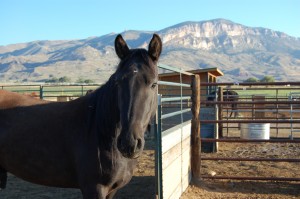
By Staci Grattan-Fornshell
“You never get a second chance to make a first impression”
Will Rogers
“With a mustang you cannot hide and you cannot lie to yourself”
Anna Twinney
Recently I had the honor of spending a week in Cody, Wyoming gentling an untouched BLM Mustang.
I have made this trip in August for the last three years to the lovely Dimock Ranch near Cody, Wyoming for a variety of reasons but primarily because as a horsewoman I am addicted to the pure horse that is the BLM mustang. The ranch owned by Michaele and Chris Dimock is heaven on earth for roughly 40 head of mustang and domestic horses.
Michaele, an avid mustang supporter and accomplished equestrian and trainer makes an annual trip to nearby Rock Springs where she takes on 6-10 mustangs to be gentled by students in Anna Twinney’s Reach Out to Horses Untouched Horse clinic. Michaele makes a very solemn promise to the mustangs she picks up at the government holding facility that they will never have to return there. She will find them all suitable homes. Homes where the contract that we begin with them during the gentling process will be kept.
Wild born BLM mustangs are gathered by a variety of methods including bait trapping and helicopter herding. They are then loaded onto trucks and shipped to government holding facilities, which incidentally often do not have shelter.
At some point they then receive a freeze brand and are gelded if they are male. The few ‘lucky ones” are assigned to a BLM (Bureau of Land Management – Federal authority on wild horses and burros) contracted trainer for training. I have heard but have not confirmed that roughly ten percent of gathered wild horses ever get adopted. Currently around 60 thousand wild born and gathered mustangs stand in government holding facilities to the tune of nearly 80 million annually for the taxpayer. The numbers are truly staggering and overwhelming. I cannot imagine the private hell it must be for a wild born horse to stand in a dry lot for years and years on end. I think I would probably choose to exit the planet if this were my fate.
The Horse/Human Contract
Allow me to preface this section by explaining that many wild born and gathered off of the range mustangs begin their introduction to the human world of training with the “rope and choke” method. In this methodology horses are roped and choked into submission and even unconsciousness. Because wild born mustangs are challenging to catch and touch for the first time, the path to expediency is to force compliance. The contract with and first exposure to the domesticated world of humans begins on a horrific note that in my opinion is a violation akin to rape.
I have written several pieces for this publication and my blog outlining my views on partnership with horses so I wont go over those points here again.
I think we can all agree that any solid partnership begins with a good contract. A contract where both parties have a voice and there is an established communication of wishes, desires and needs.
First Impressions
In order to have a contract and ultimately a partnership, we must first have an interest by both parties. Allow me to give you a scenario to further illustrate my point:
I would like you to work for me as a bodyguard, keeping me safe and trusting you with my life. Something we do with our horses regularly. If upon our first meeting, I slapped you and kicked you in the shin in an effort to get you to sit down at my table to talk, you most likely would not be very interested in further dealings with me. Your first impression of me would be that I am not someone who is to be trusted, nor am I a good communicator. Furthermore you may wonder if any people like me are worth trusting or dealing with.
BlackJack
The little black gelding with a small star on his forehead and I met on a typically beautiful Wyoming Saturday morning in August 2015 at Dimock Ranch.
At the time BlackJack did not have a name and had only very recently had the rope and plastic identifier tags been removed from his neck. He was in a pen with five other 2-3 year old BLM mustangs of varying colors and sizes. All geldings, the boys came from varying Herd Management Areas (HMAs).
BlackJack originally came from The Great Divide Basin HMA about 40 miles east of Rock Springs, Wy. The Great Divide Basin HMA encompasses approximately 700 thousand acres and has a maximum allowable mustang herd size of 500. Topography within the herd area where BlackJack grew up is generally rolling hills and the basic forage includes mixed grass and saltbrush. BlackJack had been gathered as a yearling in the fall of 2014 during the Wyoming Checkerboard Roundup. Between September 15 and October 9, 2014, the Bureau of Land Management rounded up, via helicopter stampede, and removed 1,263 wild horses from “checkerboard” lands in three Wyoming Herd Management Areas: Adobe Town, Salt Wells Creek, and Great Divide Basin. At least 14 deaths resulted from the roundup, including young horses who crashed into panels and broke their necks, and elderly, arthritic and ailing horses who were terrorized by helicopters and forced to run for miles before being “euthanized” by a bullet to the head.
The 2014 Wyoming Checkerboard Roundup decimated the wild horse populations in these HMAs, leaving behind just 91 horses in The Great Divide Basin.
BlackJack had been standing in a government holding facility in Rock Springs for nearly a year. At the time we met, I knew very little of this. I knew his basic age and that he came from Rock Springs. That was it.
As we stood outside the pen watching the horses and getting basic information I observed the little black gelding bump my friend Clea with his nose. As she absently petted him while listening to instructions he moved on to me and I began to pet him. Amused, I thought, “wow first touch done, that was easy”. As I was petting, Anna Twinney, Founder and Head Instructor for Reach Out To Horses took note and said, “there’s your first touch, and they don’t usually come that easy!”
For the next seven days BlackJack and I were partners. Throughout the course I experienced a range of emotions from extreme gratitude at this “one in a million” horse to envy that some of my compatriots got to experience horses that were more challenging to “get the first touch”. As time went on I realized this envy was misplaced. Blackjack, (originally named Jackpot – as I felt I had really hit the Jackpot with him!) had plenty of challenges in store for me and in typical mustang fashion he put my horsemanship and emotional skills to the test.
From the get go BlackJack was regarded by Twinney and her instructors to be a “one in a million mustang” at first everything was “easy”, first touch, first halter. He followed me (and everyone else) around like a dog, begging (sometimes demanding) attention. He earned the nickname “Velcro” almost immediately from the group, if there was a human in the pen; Blackjack was there like a gnat buzzing around. It was unreal. Mustangs aren’t like domestic horses; human touch is not something they naturally want. We are predators, they are prey animals. The natural instinct is to flee. It is our job to gently lay the foundation for trust and partnership. The first impression should be one of gentle kindness.
It became clear to me in very short order that my little mustang needed an altogether different first impression than his fellow mustangs but one that was equally as important. BlackJack at a glance could be considered by some to have very rude ground manners and no boundaries. It has been my experience that most horse people are either tolerate that to the point of danger or have very little tolerance for it at all. I’m not sure which of these is worse but what I did know is that this little dude was a blank slate and I had a big job to do.
As I stood inside the pen with Blackjack on our first day together my mentor Anna Twinney of Reach Out To Horses stated “he’s a baby, a clean slate.” Basically she was reminding me that this wonderful curiousity displayed was fragile and could be easily destroyed. While my friends were challenged by their allocated mustangs to get their “first touch” without force “moving through oil”, using body language and negotiation, I was challenged to mold this inquisitive brain into a trusting partner. She compounded her point using the analogy of a precocious child “ he’s exploring his world, its your job to show it to him and show him how to stay out of trouble”. So together BlackJack and I began our journey.
Photo credit Liv Bjerre
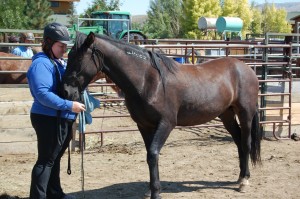
As with most any horse seeking human attention I was reminded in short order that pushing BlackJack off only made his curiosity and “pushy” ways worsen.
My horsemanship was sorely tested as I “took” several bites to the arms in those first few days. This questioning equine brain needed a challenge to show him the right path, but not too much of a challenge. It was an interesting balancing act to be sure. Too much too fast and his mustang colors cropped up quickly as I had a rearing, spinning bolting horse, too little and he was curious and bored, getting himself “in trouble”. Every second spent in that pen was a learning experience that tested my skills and my emotions.
As BlackJack and I worked together that week I was very aware of my responsibility to introduce him to this human world in a way that preserved his excitement and interest. I was proud of myself and of him as we navigated many firsts for him, first halter, first leading, farrier preparation, ropes, pads, brushing. As the time went on my “pushy” little “Velcro” transformed into a calm trusting partner looking to me for safety and direction. As a horsewoman there is truly not much more one can experience. It was and remains to this day emotionally moving.
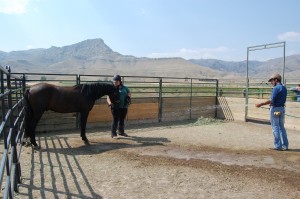
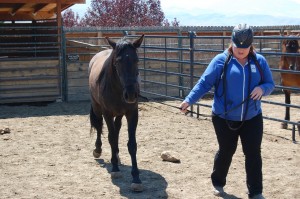
As my week with BlackJack came to a close I was asked to write a description for potential adopters. It was challenging to sum up whom this beautiful creature in a few short paragraphs.
Hello my name is Blackjack! I am a two-year-old BLM mustang from Divide Basin HMA in Wyoming.
I was gathered in the fall of 2014. I have been:
*Gentled to touch over both sides of my body
*Haltered in a rope and dually halter
*Done very basic leading in an enclosed area
*Had some basic prep done for bathing – this area needs more work and with time and patience should be fine
* Preparation for farrier in that my legs have been touched all over and I have the beginnings of the idea that I need to pick up my front feet when they are touched.
I am:
* Highly motivated by touch and praise
* Am a clean slate and have a very innocent mindset
* Likely to want to sit in your lap, my nickname during my gentling process was “Velcro”
* Curious but sometimes wary of new things – please go-slow and I will accept new things if you give me clear, gentle calm direction.
I love to have my chest and neck scratched vigorously. If I do get upset I come down easily with a calm, loving grounded person.
I am naturally drawn to people and love attention. I am a one in a million mustang!
Horsemanship is not only an intellectual journey but also a spiritual one. Each horse has something to offer on some level. I have found that the Mustang offers a pure, undiluted view of how horses see the world. My respect is immense and I am deeply moved that I have been granted permission to touch each one I have had hands on. These wild born creatures do not have to take on the human agenda. They above all horses know this. For me, this translates to domestic horses and the life lesson we should all take from the mustang is that we are given a gift each time we touch a horse, any horse.
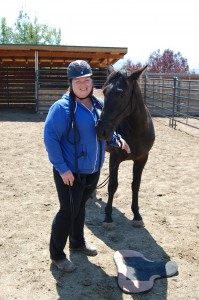
After I completed this article, I was thrilled to learn that BlackJack has been adopted by a fantastic woman in Cody, Wy. True to her word, Michaele found him a fantastic home. His new name is Santana and his new partner is Doris and who is passionate about her animals! A very happy ending for one of the 60 thousand!
For more information on how to support mustangs in the wild go to www.friendsofalegacy.org. For more information on how to adopt a BLM Mustang go to www.blm.gov . For more information on Anna Twinney and her work please go to www.reachouttohorses.com .
Staci Grattan-Fornshell and her husband Brion Fornshell co-own Spirit Horse Center in Brainerd, Minnesota. Staci enjoys using her focus on good solid horsemanship basics, true classical dressage and natural holistic horsemanship to assist horses and humans. Spirit Horse Center is located in North Central Minnesota and provides, boarding, training, lessons and regularly hosts clinics and events benefitting horse owners and horses. For more information on go to www.spirithorsecenterinc.com
A Matter of Trust -SHC blog article
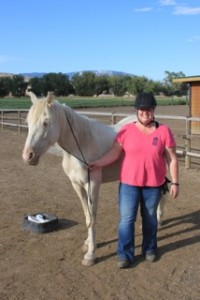
By Staci Grattan
Photo Credit: Liv Bjerre
I recently attended an eight day holistic horsemanship course near Cody, Wyoming at the beautiful Dimock Ranch. Taught by a mentor of mine, Anna Twinney of Reach Out to Horses, and a follow-up to many hours of previously completed course work, the curriculum focused on further honing my skills in ROTH’s Trust Based Partnership methodologies.I had the high honor of working for the second time in my career with some spectacular BLM mustangs from herd management areas near Cody.
During my time in Wyoming with five other highly gifted students, two spectacular ROTH instructors, Anna herself and perhaps the best teachers of all in the form of mustangs, I experienced many shifts in thinking, as a horsewoman, a trainer, an instructor and as a person.
As I sat down to write this article I began to mentally “sum up” my experiences.
I became fairly amused as a song by Billy Joel from my teenage years kept surfacing in my thoughts. “A Matter Of Trust”. A line from the song resonates: “You can’t go the distance with too much resistance”
This concept was clearly illustrated during my time spent with April, a 3 year old BLM Mustang from the McCullough Peaks HMA. April is a stunning cremello mare with blue eyes, who was gathered off the range in 2013 and has spent her time at Dimock Ranch. Initially gentled to human touch via ROTH Students last fall, April has received minimal daily handling since then. As my project for the week, I was assigned the task of working with this stoic and sensitive filly on foot and leg handling to ensure positive farrier experiences, and leg stretches for further mobility and desensitization. What we learned together was so much more.
As previously mentioned, I consider wild born mustangs to be amazing teachers of horsemanship. If one is listening or watching “for the whisper” you can tune in to a whole host of information. Untouched and wild born horses give us a pure, undiluted, untainted view into true horse behavior and language.
For my assignment with April, I was to present my progress to the instructors and class on the final day of the course. I was to work mostly on my own time to accomplish my goals. So the first day I made my way out to the large paddock containing several young mustangs to get my horse and get down to business.
Having worked with mustangs previously, I knew that catching them is always an issue, and actually can stubbornly remain an issue for life. Having experience with this and having been briefed on April’s situation, I felt confident I could catch her in a short amount of time. What I had forgotten was the mustang sense of humor and uncanny ability to humble us lowly humans. While she was not at any time running or out of control, April made me work for about 30 minutes to catch her, basically burning a whole session. I’m sure she thought it was a great opportunity to see who I was, and to remind to ASK – not tell – and to go SLOW. I am proud to say I did rise to the occasion by dusting off my rusty mustang “slow is fast” approach and ultimately it worked, as I was able to finally touch her, leading to a conversation that was to last all week.
My take away from first session:
- You think you’re asking – but you’re really telling.
As a horsewoman, I like to ask my horses as much as possible. There are times that “telling” is the only option (dangerous situations etc) however a trust based partnership comes from a give and a take. Asking “Can I touch you here? Do you like that?” Asking allows a voice and opens the floodgates for a lot of valuable information. If we listen, the horses will tell us.
Most domestic horses are very accepting. It is quite easy to get into their space and do a whole lot of things to them. We don’t ask, we just do, starting with the approach in the paddock. We bustle right up to our horses. Maybe they get a greeting, maybe they don’t. We put the halter on and we come in. Is there a hello? Is there a check in? Do we approach in a polite manner? Where are my eyes? How is my body language? How am I communicating? Is it in the language of Equus? It’s easy to forget these simple things in everyday life. April reminded me that if we were to have a trust based relationship, I needed to move slowly, communicate clearly by using proper body language and eye contact, and do a whole lot more asking – down to the simplest things such as “Can I touch your withers?”
As the week went on I worked with April and many other horses, mustangs and domestics, on a variety of things from trailer loading and ground tying to extreme behavior problem solving. My awareness of equine language and learning hit a whole new level from these experiences. However, a theme surfaced with each situation and each horse, reminding me that asking instead of telling whenever possible, opened doors.
During my personal time with April, I worked hard to be extremely mindful of her sensitivity and her appreciation at being asked even the smallest things. The more questions I asked, the more things she agreed to and the resistances faded. We had many “conversations” in which she showed me incredible things such as her ability to learn very quickly by small releases of pressure. I am quite proud to say that by the end of our time together we were able to present to the instructors and class while April was basically at liberty in her paddock with several other young mustangs. I was able to pick up all four feet, do leg stretches, and gently place each foot back in place. All this while April stood quietly with a simple short rope hanging loosely around her neck. At any time she could have easily left my company. To say it was an exhilarating moment is an understatement.
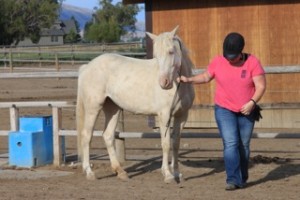
My experience in Cody offered a shift in perspective to be sure. As the days passed I began to ask myself questions about my interactions with others. As a Mother, Wife and Boss, I wondered “Could I be creating more of a partnership? Could I take the communication to the next level? Is the mutual trust in this relationship? How often do I ask permission for simple basic things?”
I invite you to remember that each time you interact with your horse you are, in effect, training him. Take a look at those interactions and ask yourself where your level of trust and partnership is. Can you take it up a notch? Are you asking, or are you telling? To be clear, asking does not mean your horse gets to do whatever he darn well pleases. Asking means just that, asking. “Can you put your foot here? Can I touch you there, or there, or how about there? If you don’t want me to touch you here, can you tolerate here?” You get the point. The big picture is creating a conversation that flows back and forth. You might just find that creating that conversation creates a whole lot of trust.
Staci Grattan and her husband Brion Fornshell Co-Own Spirit Horse Center in Brainerd, Minnesota. Staci enjoys using her focus on true classical dressage, basic and holistic horsemanship to assist horses and humans. Spirit Horse Center is located in North Central Minnesota and provides, boarding, training, lessons and regularly hosts clinics and events benefitting horse owners and horses.
For more information on go to http://www.spirithorsecenterinc.com
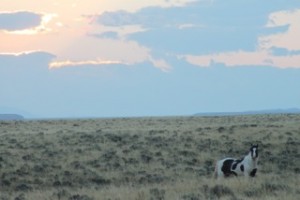
A BLM Mustang Stallion residing at McCullough Peaks herd management area looks on curiously during a visit to the wild herd areas.
The Dreaded “D” Word – SHC blog article
Dressage as I see it – An invitation for the casual rider.
By Staci Grattan – Spirit Horse Center
As a born and raised “backyard rider” I’ve had horses basically my whole life. I come from a line of “do it yourselfer” backyard horsemen and women.
As a preteen from a financially challenged family I joined 4-H and decided to give showing a go. We lived about seven miles from the local fairgrounds so every year I would ride my horses there (we didn’t have a horse trailer) and spend the week showing in 4-H classes pertaining to western riding and occasionally an open halter class. While at those show grounds I saw kids who had trainers and coaches and horse trailers and fancy saddles (and more than one saddle?) and rode “English”. I remember watching the parents “warm up” the horse and wondering why they were running their horses around in a circle on a long rope? What! Keeping in mind this was nearly 30 years ago and I was a self taught backyard rider you can understand my amazement and confusion.
This was my first exposure to “English” style riding and it formed a lasting impression.
An impression I believe many of you will be able to relate to.
I recall scoffing at the people running their horses around like crazy in circles on a long rope before the kids would climb aboard. I remember thinking “why are these people running their horses around and tiring them out before they get on?”
I remember looking at the tiny “ridiculous” saddles and thinking “yeah not in this lifetime” at the direct contact reining and thinking – “Sheesh why are the pulling on that poor horses mouth like that? That’s just terrible!” And asking the question – “don’t they do anything other than circles?!”
Words like canter, collection and contact had no place on my vocabulary at that young age and well into my 20s. Dressage and “English style” riding seemed silly, pointless and frivolous.
In my late 20s I had a pretty hot trail horse. I was in over my head but unwilling to admit it. I decided I needed “a better seat” and began exploring local riding instructors and researching training and riding concepts. I ended up with a local dressage instructor and began my love affair with dressage.
A lot has happened in my horse life since then, from private backyard breeder to commercial stable owner where I do some training and riding instruction, from training with a local instructor to training regularly with internationally recognized Natural Horsemanship and Classical Dressage experts, however my love of dressage and its most basic and simple offerings remains. Dressage is not rocket science – it’s just good solid basic horsemanship!
This article speaks to all horse lovers. However as a former casual, self taught backyard rider who was intimidated by “that fancy dressage stuff”, I invite casual riders and horse enthusiasts to explore the value of the principles, teachings and philosophy found in the oldest form of horsemanship.
Why Dressage?
1) Health, wellness and longevity.
I believe good horses are like fine wine – they just keep getting better and better. Lets face it , we put a lot of love, time and energy into our horses and we want them to last forever. Proper body mechanics by horses under saddle go a very long way toward joint longevity and injury avoidance. We know this to be true of any athlete, and horses are no different. The concept of collection as well as self carriage are valuable concepts for any horseman or woman to explore and implement. Physical collection in the horse not only makes for a more pleasant ride it also potentially saves your horse from a whole host of injuries and promotes long lasting physical strength. True physical collection and proper body mechanics are an integral teaching in Classical Dressage. Note I did not say Competitive Dressage as in my opinion that is another topic entirely.
2) Decrease negative tension.
Dressage teaches us to “ride every stride” and think ahead.
Dressage horses look “hot” and out of control to many casual observers – and they can be. However the goal and teachings of the Classical Dressage Masters I have studied and studied with is to increase sensitivity certainly but decrease tension. The more aware we are, the more “with” our horses we are. Many Classical Dressage Masters promoted a partnership and dance with the horse. Side note – horses who are moving “correctly” with heads down and back lifted are taking direction from their riders and remain much calmer– horses who are moving along in “anti collection” (term coined by Dr Deb Bennett) back hollow, head up in the air, are often not really “with” the rider, carry tension and possibly have more of a propensity to spook etc.
3) Connection, physical and mental assessment and riding preparation.
Many Classical Dressage teachings include groundwork in the form of proper mindful lunging and in hand work. Please note I say “mindful” lunging in which the horse and human are mentally connected and the human is paying attention to the horse! When I say “properly moving” I mean that the horse is coiling his loins, stepping under himself, lifting the base of his neck higher than the haunches and lifting his back as best he can based on his physical fitness level and conformation.
Not only are these things very valuable tools for connection on a deeper level, they also allow the human to do a physical and mental check in with the horse. There is huge mental and physical value to lunging done in which the horse must move correctly at a walk and a trot. Side note – do NOT underestimate the mental and physical benefit of working with your horse at a walk on the lunge line.
In hand work, as taught by several Classical Dressage Masters, also offers benefit to nearly any horseman as a tool for several reasons:
a) Lateral work done in hand such as shoulder in, keeping in mind physical limitations and conformation, offer an opportunity to address physical or mental limitations from the ground by strengthening and suppling. Difficult canter/lope departs can be improved with shoulder in work either under saddle or in hand.
b) In hand work (as well as lunge line work) offers a great opportunity to work through mental and physical issues. The saying goes “if it’s a problem on the ground it will be a problem up top!” Why not address tension, anger, insecurity issues from the ground where you are able to offer more support?
4) Contact = Conversation = Partnership.
Classical Dressage teaches us about contact with the rein. Contact is a two way conversation between the horse and rider – we do not have an unmoving “death grip” on the rein nor do we ignore it entirely until we need to stop or turn. Rather we are constantly and lightly in touch with each rein and varying the pressure by a light give and take. Contact can be accomplished with a loose rein if that is your style. The point here is that contact is a method of conversing with your horse – much like your seat and leg, we are creating a conversation and ultimately a partnership.
Any time you can broaden your horsemanship horizons it’s bound to be a positive experience. There are many “roads to Rome” and in this case many of the principles I outline above may or may not be covered in other disciplines. The true purpose as I see it of Classical Dressage is care for and partnership with the horse. Training is done on a slow and consistent basis always keeping within the comfort zone of both partners without shortcuts, or gimmicks. As truly the oldest form of organized horsemanship, dressage offers proven and time tested methods for your consideration. Check it out! You might just be amazed at how basic and simple the concepts are and how universally they apply to all levels of horsemanship and span disciplines.
Staci Grattan and her husband Brion Fornshell co-own Spirit Horse Center in Brainerd, Minnesota. Staci enjoys using her focus on good solid horsemanship basics, true classical dressage and natural holistic horsemanship to assist horses and humans. Spirit Horse Center is located in North Central Minnesota and provides, boarding, training, lessons and regularly hosts clinics and events benefitting horse owners and horses.
For more information on go to http://www.spirithorsecenterinc.com
Photos feature – Legend 8 year old Friesian X Quarter Horse gelding.
Photo 1) A shared connection and proper body mechanics on the lunge line can be beneficial in multiple ways.
Photo 2) Connection and partnership – the ultimate goal in any form of horsemanship including classical dressage
Photo 3) Lateral in hand work can be beneficial in multiple ways including addressing strength and flexibility issues, mental relaxation and focus and mutual connection.
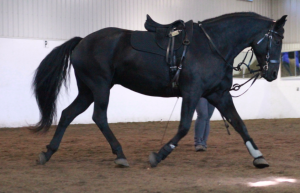
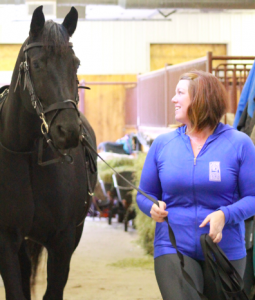
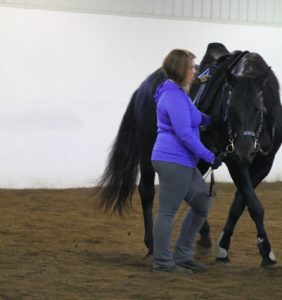
What did you say? SHC blog article
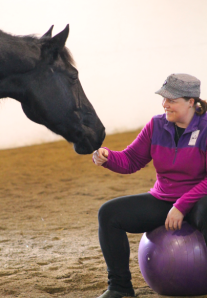
What did you say? A look at how important our words are in horsemanship and in life.
By Staci Grattan – Owner, Spirit Horse Center in Brainerd Minn.
http://www.spirithorsecenterinc.com
*This article also published in the April edition of the Valley Equestrian News
I hear these things every day in my barn. I hear them from nice, kind people who love all horses and love their own horses to distraction. I have heard them at clinics, uttered by nationally recognized clinicians. I have heard them during lessons, schooling sessions, shows, trail rides, clinics and while just “hanging out” at the barn.
I hear words regularly that give me pause:
“He is lazy.”
“He’s just always so naughty.”
“He’s afraid of everything.”
“He’s high strung.”
“She’s a spoiled brat princess.”
“She’s too sensitive.”
“She’s just a nervous horse.”
“She doesn’t really like people.”
“Who are you using today for your lesson?”
“I’m going to go work my horse.”
“We have to work him through it!”
Overheard while auditing a clinic recently:
“When we ride a 1500 pound animal with a brain mass the size of a snapping turtle, we have to expect these things.”
“He’s not going to be able to do it but let’s see what we get.”
We “horse people” like to talk (a lot) about our horses, your horses, the horses across the road, horses on TV and horses on the internet. We love our horses. We love to talk to them and about them. But what are we really saying?
I imagine what many of you are thinking at this point is, “My horse IS lazy doggone it!” Or “My horse doesn’t understand what I am saying anyway!” I would ask you , is he lazy? Or is he merely living up to your oh-so-low standards?
I would point out that while horses may not understand words, they are excellent readers of body language, and what we say becomes what we think. What we think is how we act. Whether we know it or not, I would dare say our horses know exactly what we think of them.
A mentor of mine once asked the following question:
“Why are we working our horses? Why are we not instead working with them?“
To truly excel in horsemanship, I believe we must partner with our horses, like dance partners. One leads but both must be willing and have a voice. Horses DO NOT have to do the things we ask them to do. Most of us have seen terrible examples of horses that have decided they are NOT going to carry out the human agenda any longer. How can we truly connect in partnership with an individual we refer to as “lazy” or continually focus on his tendency to be “nervous” or talk about “working” or “using” him?
The giving capacity of the equine heart is so incredible that many horses will perform regardless of poor partnership or lack of positive support, or, in some horrible cases, even inadequate food and water. Think, however, of the amazing results and joy one could experience in true connection and partnership!
I challenge you to consider your relationship with your horse. Redefine it. Get some clarity. How are you talking about him and to him? What do your words communicate and set as an intention for your relationship? Is your negative vision impacting your relationship with your horse? Is it impacting your relationships with other humans?
Shifting your wording, and ultimately your perspective, may make all the difference. A few examples:
From: “He’s very lazy/naughty.”
To: “He’s very smart and laid back. It’s fun to think up new and different ways to motivate/challenge him!”
From: “He’s so high strung/nervous/afraid of everything.”
To: “When we work together I focus on being a good strong, grounded leader for him to feel safe with.”
From: “She’s spoiled/too sensitive.”
To: “I really love that she lets me know when something isn’t right so I can help her stay in optimal physical and mental health.”
From: “I’m going to go work my horse.”
To: “I’m going to go work/play WITH my horse.”
From: “Work him through it.”
To: “I’ve picked a clear direction and I’m just going to stay with it and see what happens.”
Words have power. A lot of power. They set intention. They communicate feelings, instructions and a whole host of other information. We use our words daily to communicate with each other and our animals. What we communicate is as important as how we communicate it. Words translate into results.
I offer these thoughts in the hope that you will consider your words and your perspective the next time you talk to or about your horse, or for that matter, your child, spouse or sibling. You just might find that a few little words make all the difference!
Staci Grattan and her husband Brion Fornshell co-own Spirit Horse Center in Brainerd, Minnesota. Staci enjoys using her focus on good solid horsemanship basics, true classical dressage and natural holistic horsemanship to assist horses and humans. Spirit Horse Center is located in North Central Minnesota and provides, boarding, training, lessons and regularly hosts clinics and events benefitting horse owners and horses. For more information on go to http://www.spirithorsecenterinc.com
Compost and Manure Free
COME AND GET IT – We have great compost, manure and black dirt TOTALLY FREE for a limited time.
We will charge a very nominal loading fee for fuel.
Call us for loading days and details today 218-825-4944
We have volunteer opportunities
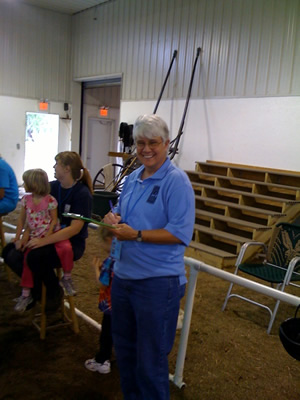 Looking to Volunteer?
Looking to Volunteer?
We have volunteer opportunities available for teens and adults. Contact us today for more information. 218-825-4944
Photo: Nancy Smith volunteers for our Little Spirits Summer Day Camps – thanks to Nancy and all of our amazing volunteers!
Composting program turns waste Green
We compost!
Spirit Horse Center has its own composting program that eliminates manure and bedding in an environmentally friendly way.
We use an aerated composting system that blows air into the waste, which stimulates the micro-organisms that are already in the mix. Their by-product is heat. Within 30-60 days, the heat breaks down the material to dirt that is an excellent source of macro- and micro-nutrients as well as stable organic matter, all of which support healthy plant growth.
The process also produces conditions within the core of the pile that eliminates offensive orders, and the high temperatures destroy fly larvae and weed seeds, which improves horsesâ health and yields a high-quality finished product.
For more information on the composting system, click here.












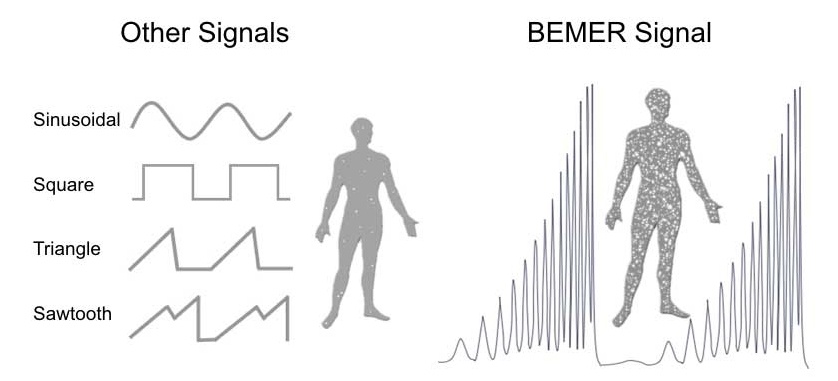
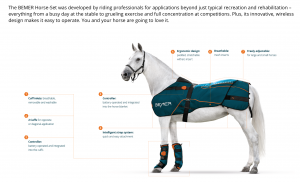
















 Looking to Volunteer?
Looking to Volunteer?